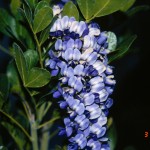Texas Mountain Laurel, Mescal Bean
Sophora secundiflora
Fabaceae (Legume family)
Description
Mescal bean is a woody evergreen shrub less than 10 feet tall or, in limited areas, a tree growing up to 35 feet tall. It is a member of the legume family. The leaves are alternate with seven to 13 leaflets. The flowers are purple and strongly fragrant. The fruit is a large, hard, woody, jointed, one- to eight-seeded legume pod. The seeds are bright red, hard-surfaced and about 0.5 inch long.
Habitat
This plant is most common on limestone hillsides and canyons. In Texas, it grows in the southern edge of the Edwards Plateau, in shallow soils of the Rio Grande Plains and occasionally in the western part of the Edwards Plateau and Trans-Pecos regions. It also grows in New Mexico and Mexico.
Toxic Agent
Quinolizidine alkaloids are the toxic agents in mescal bean. Sheep and goats are poisoned under range conditions. Cattle are also susceptible, based on results from feeding experiments. Individual animals vary considerably in susceptibility. Sheep and goats fed toxic doses of about 1 percent of their weight in mature foliage were susceptible to attacks for up to 12 days. Whole seeds pass through the digestive system intact and harmless. Ground or chewed seeds are more toxic than mature foliage, which is considerably more toxic than young foliage.
Signs of Livestock Ingestion
Signs are nervous in character and rarely fatal unless broken or masticated seeds are involved. Signs include: Exercise-induced trembling; Stiff gait; Falling, with inability to rise; Returning to normal within 5 minutes if left alone.
Forced exercise may cause signs to return.
Management Strategies
When other forage is scarce, give animals supplemental feed to prevent them from eating poisonous amounts of mescal bean. Confine affected animals and feed them a good ration until they recover. Good range and grazing management practices usually eliminate problems with poisoning.
Images
Plant Characteristics
Flower Color: Purple
Seed Type: Bean/Pod
Duration: Perennial
Stem Texture: Hairless/Smooth
Growth Habit: Shrub (Woody)
Leaf Shape
 : Pinnately Compound
: Pinnately Compound
Season: Evergreen
Distribution
 : 02 - Gulf Prairies and Marshes, 05 - Cross Timbers and Prairies, 06 - South Texas Plains, 07 - Edwards Plateau, 10 - Trans-Pecos
: 02 - Gulf Prairies and Marshes, 05 - Cross Timbers and Prairies, 06 - South Texas Plains, 07 - Edwards Plateau, 10 - Trans-Pecos
Distributions
Distribution refers to the ecological region in Texas that a plant has been found. You can also view a clickable map.
Book: Toxic Plants of Texas (B-6105)
Collection: Toxics
Livestock Affected: Cattle, Goats, Sheep
Livestock Signs: Stiffness, Trembling





